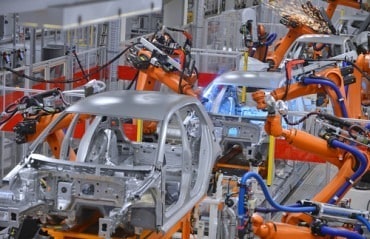
Evolving into talking personalized assistants, chatbots are revolutionizing customer care and marketing. And they’re just warming up.
Enterprises facing abrupt spikes in incoming and abandoned queries are looking for new, agile, economical ways to respond. Enter chatbots. Many customers like the option of conducting an entire conversation without a human on the other end. Businesses like the savings in overhead costs.
So it’s no surprise that chatbots are swiftly popping up everywhere. More than just automated respondents, chatbots also can help enterprises absorb call volume and deliver service quickly. It makes sense that the technology has matured into a full-scale cloud cognitive service, ideally suited to efficiently performing repetitive jobs.
See also: Insight Highlights from the 2019 Transform Conference
If that hasn’t convinced you about a rosy future for Conversation as a Service (CaaS), a recent study by Grand View Research might. The firm forecasts the chatbot industry size will increase exponentially, to $1.25 billion by 2025.
What might Conversation-as-a-Service mean to the future of customer interactions? What is the likely future of voice bots and CaaS?
Easy, On-Demand Deploy for SMB’s
Predictions of chatbots saving billions for businesses by 2022 may not be realized without adoption by small and medium-sized businesses. Instant, on-demand deployment is key. A good example is a user-friendly, live chatbot recently introduced by Appy Pie, which can be configured by nearly anyone in minutes. Besides driving interactive conversations, the product also features a three-panel display. That lets enterprise users conduct multiple conversations simultaneously, analyze responses from specific geographies, and scrutinize website traffic.
See also: Appy Pie Integrates Machine Learning into DIY App Builder Platform
The ability of such new chatbots to speedily close help desk tickets, with capabilities ranging from basic to advanced, without needing any special technical resources, bodes well for a bright future in customer experience.
But there’s more. “Chatbots can bring about an exciting efficiency, not just in your customer service department, but also in the entire organization as a whole,” says Scot Small, CEO of Appy Pie. “Your teams would be able to invest their time in productive tasks that need human involvement.”
Small says the company’s chatbot builder, which lets non-coders create chatbots at a fraction of previous costs, could be a game-changer, especially for startups and small business. Coupled with CaaS, he believes, DIY chatbots will be a big disrupter.
Personalized Customer Marketing
Oracle says 80% of marketers plan to use chatbots in campaigns by 2020. Many are attracted by the promise of delivering personalized experiences that provide a competitive edge. As campaign strategy shifts towards on-demand sentiment, chatbots have been unleashed to process massive volumes of customer data and personalize target groups.
Besides collecting the basic data such as name, email, location and device, advanced chatbots can engage in interactive conversations that reflect customer preferences and issues. And data processed by chatbots could be used to predict customer behavior and fine-tune business decision-making.
And, thanks to their human-like chatting ability, chatbots can serve as autoresponders to customer emails. Cookies make it possible for businesses send exclusive product ads based on a user’s search activity.
Big business has noticed. Facebook, with 1 billion users, employs 30,000 chatbots to help businesses converse with prospects without human intervention. Dutch airline KLM says it saw a 40% rise in customer communication though their bot on the Facebook messenger. Besides addressing run-time issues, these communications assisted customers and let them know about the latest offers and discounts.
Leading CRM service providers have jumped at the chance for seamless integration with Facebook, which can provide deep insights into the performance of chatbots along with other marketing metrics. Salesforce in 2018 found 69% of the people seeking speedy answers were comfortable interacting with a bot.
Researchers warn: Bots or Bust
A recent study by Juniper Research found the global number of successful retail chatbot interactions will reach 22 billion by 2023, up from an estimated 2.6 billion in 2019.
According to the new research, AI in Retail: Segment Analysis, Vendor Positioning & Market Forecasts 2019-2023, chatbot use by retailers will enable effective automated customer interactions for retailers.
Juniper said bots can deliver high-quality user experiences in a low-resource way, boosting customer retention and satisfaction while reducing operating costs. A crucial enabler will be NLP (Natural Language Processing), which Juniper said will dramatically reduce the failure rate of chatbot interactions, by making them more natural and valuable for customers.
The firm warned that retailers failing to adopt chatbots will face strong challenges from more technologically-adept disruptors, who will use chatbots as an extension to the crucial omnichannel retail experience.
Voices Rising
Three of the most agile industrial ecosystems – retail, food, and banking – have successfully deployed voice-enabled chatbots. A survey by Capgemini in 2018 found 56% of users were satisfied with ordering food using a voice-bot; 44% have made bank transfers through them; 38% made an instant purchase via voice command to a bot.
As organizations move away from text interactions, chatbots voices are growing stronger, thanks to advances like vernacular language skills that help expand brand reach. Many healthcare organizations are utilizing speaking chatbots to handle common patient queries and solve problems.
Hello CaaS? VoiceBot here…
Some surveys predict that chatbots will replace thousands of humans. That’s not a given, however. It’s just a shift of profiles; the average customer service rep will need to must take up more complex issues, and leave basics to bots. Future fantasy? According to a Gartner Report, 85% of support tasks will be driven by chatbots by 2020.
In fact, with Google’s demonstration of Duplex, voice-bot assistants could go mainstream sooner than expected. From making and receiving bookings to driving conversations, voice-bots are today’s newest employees. Google says voice searches could increase from 20% in 2017 to 50% by 2022.
Evolving rapidly from a mere text application to a personalized assistant, chatbots are revolutionizing customer care and marketing. And they’re just getting warmed up.





























